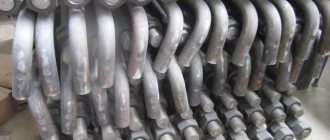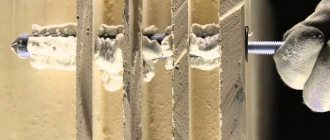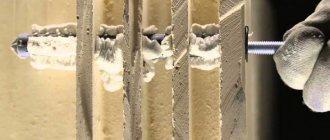Rare repairs can be done without drilling into the walls. If they are made of brick, it is important to familiarize yourself with how to carry out such manipulations before starting work.
Before drilling into a brick, you need to select a tool. The most common options are a drill and a hammer drill. The latter is a professional device, which means that with its help you can cope with the task in a shorter time. If you plan to use a drill, then the main thing for it is to choose the right drill.
Methods for drilling bricks
Drilling a brick wall can be done in one of three ways:
- manual work method;
- electromechanical tools;
- using automatic drilling technology.
The first method is the simplest, but less technologically advanced. It is used if the master does not have the appropriate equipment. Electromechanical technology allows drilling to be completed in a shorter time. For this purpose, a hammer drill or drill is used. As for automatic drilling, it can be used to make holes of impressive diameter - up to 110 mm.
Manual drilling method
Drilling holes in a brick wall using this technology is carried out if there is no electrical equipment. All you need is a hammer and a bolt. The latter is a metal tube that you can make yourself or purchase ready-made. If you resort to the first solution, you will need to prepare a 30 cm piece. The diameter of such a device should be 25 mm or more. Notches are made at one end.
The technology suggests itself if you imagine these tools: once the location for making the recess has been determined, the bolt is installed at a right angle to the wall, and its other end should be struck with a hammer. The bolt rotates, which will prevent the formation of large amounts of dust.
Electromechanical drilling technology
In order to drill a wall in a shorter time, you should use technology that requires the master to have a drill or hammer drill. In the first case, you need to make sure that the equipment has a shock function. Otherwise, you will have long and monotonous work, which, among other things, may not allow you to achieve a positive result.
The ease of the process will depend on the number of revolutions and power of the tool. The most suitable value for the number of revolutions is considered to be 2000 or more. With an increase in this parameter, you can count on the fact that the hole can be made in the shortest possible time. If you are just planning to purchase a drill, it is important to make sure that it has a keyless chuck and a reverse function. In the first case, you do not have to additionally use a clamping wrench.
Drilling can be done right through the brick. For this purpose, a hammer drill with diamond bits is often used. The working part of the equipment must have rounded edges. This equipment should also have an impact option. In order to avoid placing a large load on the hammer drill and consumables when it is necessary to make holes of impressive diameter, you should start with small drills and finish the work with large ones.
If you have warm ceramics or hollow products, you need to turn off the impact function, as this may destroy the material. If the brick has a high grade and good strength, which also applies to clinker products, the electrical device is set to medium speed, otherwise the equipment may become dull.
Attention! If the wall needs to be drilled for installation of a hood, socket or plumbing system, diamond drilling should be used. For this purpose, a crown with especially strong teeth is selected. If used with the tool in impact mode, it may cause the base to be torn out. In order to eliminate such a nuisance, you need to start drilling from the masonry seam.
Automatic brick drilling
If you need to drill a brick wall in a hard-to-reach place, for example, in a corner, or you need to make a recess of impressive diameter, ordinary tools will not help. Here you should use automatic technology, which involves the use of special installations.
Typically, the process involves crowns with a diameter of 2 cm or more. The drilling depth can reach 4 m. This technique is good because it is silent, and 1 cm of thickness can be overcome in a few tens of seconds. To operate such equipment, you need water and an electrical connection. The tool is fixed on a vertical surface, then water is supplied to the drilling site. The work is carried out automatically without human intervention.
How to drill holes
Using the completed markings, holes are drilled in the brickwork. The work takes place in several stages:
- We make a notch with a core so that the drill does not slip and go to the side during the work.
- We position the tool exactly, horizontally. The crown has a guide drill. The final result of the work depends on how smoothly the drilled hole is made. An unevenly made hole will definitely result in the inability to properly install the box under the switch or install water supply and sewerage. Drilling a wall at an angle leads to rapid failure of the drill.
- We start drilling at slow speeds without impact. After deepening approximately 0.5 cm, you can turn on the fight.
Before you start drilling brick, you should put on personal protective equipment: glasses, headphones and a petal respirator.
Drilling tool
If you're wondering what to use to drill into a brick wall, there are several options to consider to decide which one is right for you. The simplest method is mechanized, which involves the use of a hammer and a bolt. This work algorithm will not allow large-scale work to be completed, but if there is only one hole, this approach will be ideal.
A more technologically advanced method compared to manual drilling is the electromechanical method. Here you can’t do without a drill, or, at a minimum, or at a maximum, without a hammer drill. It is better if the drills and augers are new, then the work will go faster. But diamond drilling of brick walls is usually carried out by professionals. It usually does not produce dry dust, but the work area will still require cleaning. The thing is that diamond drilling is accompanied by cooling of the equipment with water. However, only specialists can cope with such a task.
Attention! If you plan to drill brick walls yourself using electric household tools, you need to not only mark the hole, but also core the future hole. This will prevent the drill from slipping.
We solve the problem with our own hands
A homemade tool saves time and solves the problem no less effectively. The work involves punching, enough so that the device can withstand brute force and not break on a solid obstacle.
Jumper
A bolt is a piece of pipe that has teeth on one side. They are cut out with a grinder. In this case, it does not matter at what angle the points are made - straight or with a slope.
The principle of use is that the pointed end is applied to the piercing site. The reverse is hit with a heavy hammer or sledgehammer, turning the pipe.
Homemade bolt
The result is a hole of the desired diameter with neat edges. The process is labor intensive. Significantly saves the budget on all counts.
Homemade crown
You can make a strong crown to interact with brick with your own hands.
To assemble the nozzle, take a piece of pipe and cut teeth on one side, similarly with a bolt. On the other hand, they are cut to the required depth, close to the manufacturer’s product.
A piece of reinforcement is installed in the center, to which a crown is welded along the inner edge with short sections of pipes.
The next step is to insert the drill into the electric drill chuck and start punching.
The length of the shank is independently adjustable, resulting in a recess of the desired size. It is possible not to drill several times to the required diameter, but to make a nozzle of the required diameter and drill the wall once.
Selecting and purchasing a drill
The diameter of drills for making holes in brick usually varies from 6 to 8 mm. This value is average, as is the depth, which is usually 15 cm. To make holes with more impressive parameters, it is better to use a drill. Its length reaches one meter, but it is used in conjunction with a drill and a hammer drill. The first one must have the function of a hammer drill.
When there is a thick wall, it is better to act in several approaches. To begin with, a 20-centimeter drill is used, and the recess is approximately 15 cm. Then the depth should be increased to 40 cm, and at the final stage - to 50 cm. During this process, a hammer drill will be needed.
Attention! The presence of an outlet on the wall will help identify and naturally not affect communications. If you don’t have the appropriate equipment at hand with which you can find out whether the wires are running inside, you can follow the first recommendation. But the electrical wiring must be de-energized in any case.
Advantages of impact drilling machines for concrete
List of advantages of this class of tools:
It is very convenient that after use the device can be put back into the case with which it was sold.
- autonomy and the ability to hold a charge for a long time (for models without a mains cable);
- easy drilling of durable materials;
- drilling speed adjustment;
- energy intensity and power, represented by varieties for each specific type of work;
- safe use due to low voltage even in wet conditions and in open areas of the construction site;
- the ability to work in hard-to-reach places and remote from communications;
- storage in a special case.
The main parameter that characterizes the device when choosing is the power with which it operates and the number of drill rotations per minute. The higher the number of revolutions, the better.
How to make a hole in a brick wall
Before drilling into a brick wall, you need to check for electrical wiring. Then marking is carried out. You need to decide on the parameters of the recess. Depending on this, drills, drills or crowns will be selected.
Preparing tools
If you plan to use a drill, its power should not be less than 600 W, and the number of revolutions should be approximately 2500 or more. Make sure the equipment has a reverse function so you can adjust the power. Brick is resistant to static loads, so the equipment must have an impact option.
The material should be influenced dynamically, only then will it be possible to achieve results. This is why a household drill is not suitable for the process. If you still decide to take a risk and use such a device, you may be faced with the need to repair the drill, since its motor will certainly overheat and fail.
Preparatory work
In addition to electrical wiring, there should be no fittings in the wall. To find it, you should use a metal detector. If there is no tool to find the wiring, you need to make sure that it does not pass through the seams under the layer of plaster. To do this, before starting drilling, you need to deepen the seams a little.
Drilling holes in a brick wall
To make an even recess, you need to install the drill perpendicular to the wall. First, several short inclusions are made so that the equipment deepens a few millimeters. Next, you should begin the main process, removing the drill from time to time and allowing the drill to rest a little.
Where to start repairing a brick wall
Repairing damage to the wall can only begin after it has been stabilized. This means that the fault is no longer growing. Otherwise, you will be wasting time and money on materials. We tell you how to diagnose.
- Apply a cement or plaster strip to the tear site and monitor its condition for several weeks. If no changes have occurred within 4-5 weeks, you can fix the problem.
- Instead of cement, attach plate beacons to the masonry and determine the dynamics of the rupture using the scale on them.
- For these purposes, use a paper strip glued with silicate glue. If it remains unharmed, you can begin work.
The last method is only suitable for dry rooms. The optimal length and width of the strips is 10*4 cm, if the damage is small (up to 10 mm). Before installing beacons, you must first remove plaster, dust and dirt.
Useful advice from professionals
If you have a solid wall, it is better to choose a pobedit drill. Only it can cope with particularly durable material and not wear off completely. Such equipment lasts longer, and can be used even after that.
In everyday life, 15-centimeter drills are usually used, but on sale you can also find auger drills, which have impressive dimensions and are suitable for hammer drills.
How to make a hole without defects
In order to avoid unpleasant consequences, you need to make sure that there is not only electrical wiring in the wall, but also water and sewer pipes, which are often hidden in the masonry. The presence of electrical wiring can be indicated by a socket on the wall; wires from it run to the switch.
How to drill without dust
If the room is already finished, such a need may arise. If the electric tool you are using does not have a connection pipe for connecting a vacuum cleaner, you can use the help of a second person who will remove dust as soon as it begins to spill out of the new hole, leaning the suction tube against the recess. If you work independently, you can place something like a shelf at the point of impact on the wall, where all the dust will fall.
Creating a Niche
If you plan to drill a recess larger than 20 mm or need to create a niche for a socket, you should purchase a Pobedit drill bit. Multiple holes are made along the intended line, the jumpers between which are then removed using a chisel and hammer. An alternative and more technologically advanced solution would be to use a hammer drill and a crown together with it.
Drilling holes in concrete using a hammer drill
There are several options for drilling holes in a wall using a hammer drill, and they all depend on the density of the concrete, as well as the availability of the necessary tools. Let's start our story with the simplest methods and end with the most labor-intensive ones.
Drilling holes using a crown for socket boxes
If you don’t know how to drill a hole for a socket in the wall, then just ask the store for a crown for socket boxes. This is a very simple device that greatly facilitates this labor-intensive work.
The crown for socket boxes consists of four elements. The first is the basis. It is a pin for mounting in a hammer drill, with a flange for screwing on the crown. The crown is a piece of pipe with a diameter of 68 to 80 mm.
At its ends, on one side there is a thread for fastening to the base, and on the other end there are carbide cutting elements. In some crowns, these cutting elements are coated with diamond, which increases their service life. The third element is a drill, which is also secured to the base using the fourth element - a screw. Purpose of the drill: centering the crown.
The price of such a crown is within very reasonable limits. Therefore, if you have started a renovation that involves moving electrical points, we highly recommend that you buy one. It will always come in handy on the farm.
First of all, we mark the installation location of our new outlet.
The centering drill of the crown protrudes slightly above the edges of the crown itself.
Drilling holes using a crown and drill
Using a crown, you will get the hole you need. But this will not always be so easy to do. The fact is that this crown copes quite well with brick and some types of concrete. But sometimes she is powerless. And then you have to invent another way to properly drill a hole for sockets.
- If the crown does not handle your concrete well or at all, then you will have to use a slightly different method. Let's look at it step by step.
- First of all, as in the first option, we find the center of our future outlet. Then we drill a hole for the centering drill. We take a crown and try to drill a hole with it.
- This didn't work out for us. But there were clear traces of our future hole on the wall. They are what we need. Now, using a regular concrete drill, make several holes along the edges of the future hole with your own hands. The greater their number, the easier it will be for us later, so make about 20 such holes in them.











